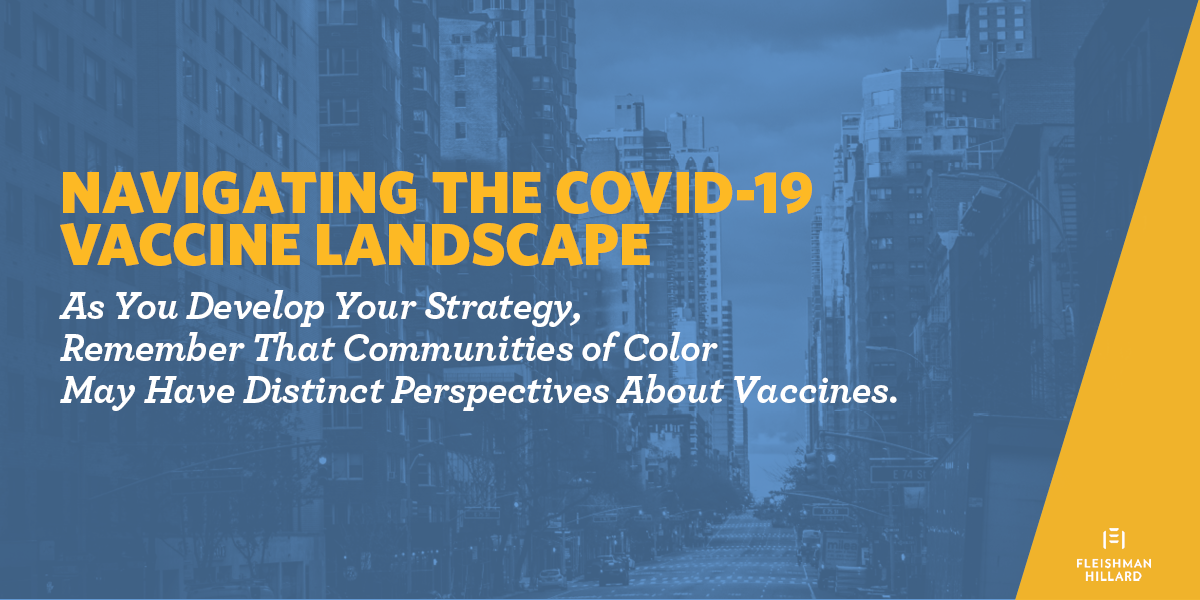As You Develop Your Strategy, Remember That Communities of Color May Have Distinct Perspectives About Vaccines
COVID-19 has disproportionately affected Black, Latinx and American Indian communities … not due to genetics but rather the result of longstanding, systemic health and social inequities. As a result, these communities have experienced higher rates of COVID-19 and higher mortality rates. Some of the factors contributing to increased risk include discrimination; healthcare access; occupation; education, income and wealth gaps.
The guidance that follows can help start/inform conversations and considerations as your organization discusses COVID-19 and vaccinations with Black, Latinx and American Indian employees. This guidance isn’t exhaustive. Before engaging with a specific audience, it’s a good practice to do further research to learn more about their experiences, as there are additional cultural nuances to consider. The Reagan-Udall Foundation for the FDA has shared some of the perceptions of vaccines held by people of color as part of its COVID-19 Vaccine Confidence Project.
Why different communities of color may be hesitant to take the COVID-19 vaccine
History of unethical clinical experiments: Some Black, Latinx and American Indians may hesitate to seek care because they distrust the government and healthcare systems responsible for unethical clinical experiments on communities of color. Examples of this include experiments, such as the Tuskegee Study of Untreated Syphilis in African American Males and mass sterilization of American Indian women without their permission in the 1970s.
Implicit bias in healthcare: Implicit biases or outside conscious awareness are proven to impact doctor-patient interactions, often resulting in lower-quality care for communities of color. For Black, Latinx and American Indian patients, this can lead to distrust of doctors and nurses and cause them to not seek care. Examples of implicit bias in healthcare include pregnant women of color facing discrimination because of their race, ethnicity or socioeconomic background or the myth that Black people experience pain differently than white people.
Lack of outreach to people of color regarding vaccination: Although Black, Latinx and American Indian people are at higher risk of getting COVID-19, and it’s known that these groups are more hesitant to get the COVID-19 vaccination, research has shown that states are not making a concerted effort to reach these high-risk populations. By not effectively communicating, miseducation, confusion and distrust grows. For example, communities of color have watched the speed at which the COVID-19 vaccines have been developed and are distrustful. They are concerned that shortcuts were taken developing the vaccines and that not enough people of color were included in clinical trials. Other factors, such as language barriers or the spread of misinformation on social media, increase the need to reach these communities with accurate information about COVID-19 and the vaccines.
Considerations for employers
- Don’t think about vaccinations as an isolated event, but keep in mind the historical context for communities of color. When employees express concerns about the vaccine, be willing to consider historic and systemic issues and inequities that might contribute to how they’re feeling today.
- Keep in mind the varying degrees of access and barriers to receiving the vaccine people face. Some may not have transportation or child care, others may not have paid time off. All are barriers that will keep some employees from getting a vaccine. Consider how to leverage business resources to address these barriers – for both your employees and society at large. Some companies are offering additional paid time off, and others are making large spaces available as vaccine sites. For a tech company, this may include promoting access to educational resources and combatting misinformation. For a transportation company, this may include providing free/reduced rides to vaccination sites.
- Many employees are still forming their view of the vaccines and may look to employers for information. Offer guidance and answer frequently asked questions through internal communications. Identify experts and trusted spokespeople who can be available to talk things through with employees.
- As you educate employees, include employees of color sharing their stories of getting vaccinated. Highlight the importance of having collective concern, not just for one’s own self, but also for one’s fellow colleagues. Tell the stories of older employees, those with pre-existing conditions and those taking care of children or sick relatives at home.
- Be mindful of when the company should defer to industry groups, healthcare experts or cultural groups. When appropriate, provide information and encourage employees to seek expert resources to learn more about the vaccine for themselves.
FleishmanHillard’s 2021 Health Checkup: Survey of Patients’ Perspectives of Issues, Inequities and Reputation (a survey fielded by TRUE Global Intelligence, the in-house research practice of FleishmanHillard, surveying 1,002 adults 18 years and older in the United States from December 15-28, 2020), found:
- Only 44% of Black Americans said they trust the fast-track process to develop vaccines that are safe, and just 41% said they trust the fast-track process to develop vaccines that are effective.
- Slightly more Hispanic/Latinx Americans said they trust the fast-track process to develop vaccines that are safe (54%) and effective (51%).
- In comparison, 60% of the U.S. general population said they trust the fast-track process to develop vaccines that are safe, and 58% trust the fast-track process to develop vaccines that are effective.
View the “Your Next Defining Moment: Navigating the COVID-19 Vaccine Landscape” report here.

